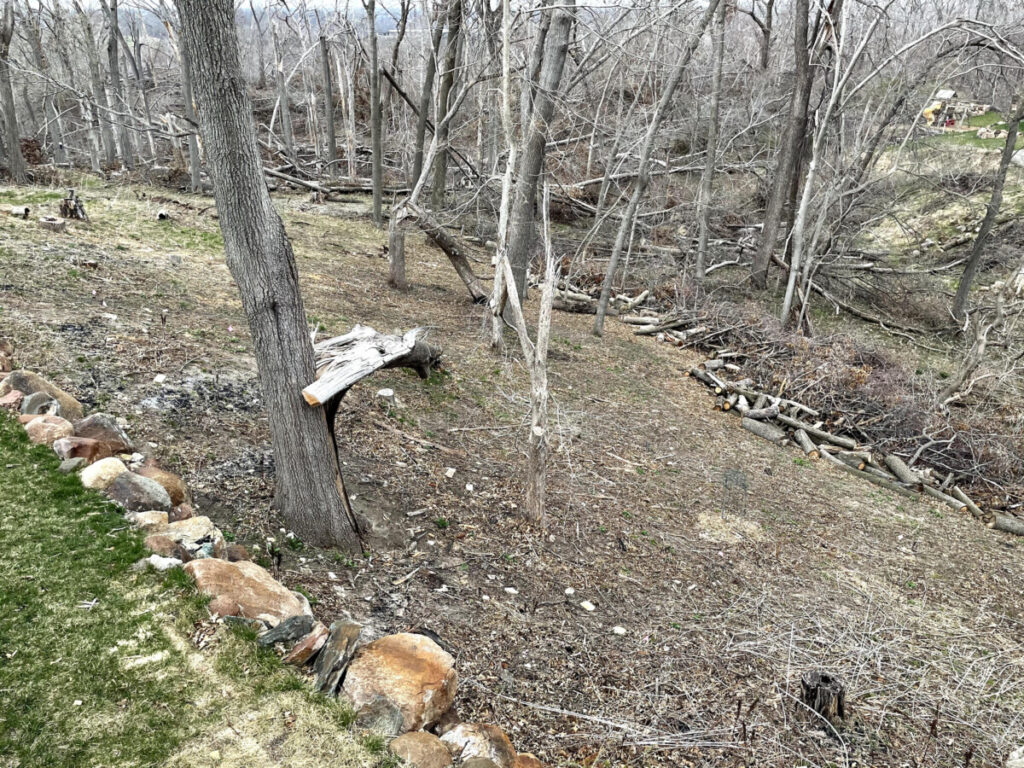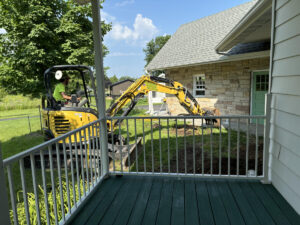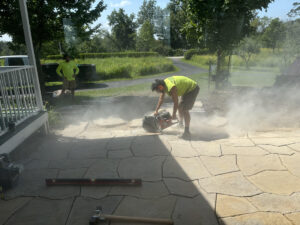by Winding Pathways | Sep 26, 2024 | Flowers/Grasses
Serendipitous Derecho
We sat on our back deck one early September evening remarking on the delightful wildflower progression we’ve enjoyed since early April. It is the serendipitous result of a disaster.
On August 10, 2020, a derecho’s 140-mile-an-hour wind knocked down almost all the trees. That led to days of chainsawing and hauling off firewood and brush. A few trees survived, but land that had been shady for decades was now in either partial or full sunlight.
What a change the storm made by transforming shade to sun! We planted some wildflower seeds, but the huge resurgence of flowers came from seeds that had remained dormant in the soil…..the seed bank … ..for years waiting for the right conditions to sprout.
-

-
The once shady hillside lay exposed to the sun.
-

-
Bare hillside
This Growing Season
April: Spring ephemeral flowers appeared. Anemones, spring beauties, Jacob’s Ladders, ginger, and bloodroot bloomed. They are called ephemerals because they don’t last long and soon disappear.
May: Our entire former forest was carpeted with toadstool-shaped May apples. Many sprouted beautiful white flowers that are, unfortunately, mostly hidden under their large leaves. After they fruited the plants faded away to be replaced by summer bloomers.
June, July, and August: Summer flowers added color. Pale purple, yellow, and purple coneflowers and woodland sunflowers bloomed amid thriving big and little bluestem grasses. Unlike earlier flowers, these stay in bloom for several weeks.
September: Goldenrod began blooming around the first of September and was soon joined by a fresh snowfall!!!!! Well, it wasn’t really snow, but so many white snakeroots came into bloom that our former woodland looked like newly fallen snow with golden sunflowers mixed in.
White snakeroot!

The hillside glows with goldenrod and a snowy carpet of snakeroot.
It’s toxic to most mammals and once killed people, but we’re not worried. If we had a grazing milk cow she might eat snakeroots and ingest a toxic alcohol that she’d void through her milk. Years ago, people drinking her milk may have sickened or died. It’s not a problem today since cows generally don’t graze in woods, pasteurization drives off the alcohol, and store-bought milk is usually a blend from many cows. So, without worry, we enjoy our snakeroot.
We are enjoying the progression but know it won’t last. Young oaks, hackberries, black cherries, and hickories have sprouted in the area. Someday, probably long after we’ve departed, our area will again be a shady woodland.
by Winding Pathways | Sep 19, 2024 | (Sub)Urban Homesteading, 1080 Labyrinth Blog, Garden/Yard, Nature, Wonderment
Partnership with Sustainable Landscape Solutions Creates Natural Beauty

Brilliant flowers
When we bought our home near Cedar Rapids in 2010 we had a vision to transform the yard that had been sprayed and manicured by its former owner into a wondrous place, brimming with natural beauty and fascinating wildlife. It would be a delightful yard with prairie and savanna wildflowers bouncing in the breeze, and goldfinches and swallowtail butterflies winging over. We sought to create natural beauty.
We have years of ecological restoration experience. Rich had been restoring prairies and oak savannas since 1975 in his position as executive director of two nature centers. Like Rich, Marion is an inspired naturalist and a labyrinth expert. Together we had managed our former home for diversity, but the new property offered more space.
Beginning almost immediately, we planted prairies in portions of our front and back yards and worked with Linn County Roads to restore prairie in the nearby road ditch. This helped hold runoff water that could percolate into the ground.

Working together.
Fortunately, we have experience managing fire. Rich is a former US Forest Service Hot Shot (wild firefighter) and we’ve used prescribed burns to help nurture the prairie. Burning has helped us resurrect native plants and wildlife.

August – Joy is a part of labyrinths.
In their largest prairie Marion crafted the Phoenix Harmony Labyrinth. This is a five-circuit, dual-entry path to the center where people can enjoy a bur oak and be surrounded by prairie grasses and forbs. She welcomes people to play and encourages anyone wishing for moments of contemplation to visit and walk its curving paths between blooming prairie plants. Her labyrinth is listed on the international labyrinth locator registry.
How Sustainable Landscape Solutions
Helped the Pattersons

Several organizations and businesses are collaborating to create and manage the prairie.
We needed help with our newer projects. “We wanted to transform a hilly patch of our front lawn into a prairie rich in wildflowers and fewer tall prairie grasses. The site was a long-established conventional lawn composed of exotic grasses,” said Rich. “That’s a challenging environment to establish prairie. I’ve established prairies on lawns before by broadcasting seeds and following up with prescribed burns. But, it’s a slow process. We wanted to speed up restoration and needed help killing the turf and preparing the soil,” he added.
In 2020 we hired Sustainable Landscape Solutions to do the prep by first spraying the existing turf and later working the soil. Pattersons took it from there and planted a seed mix they purchased from Pheasants Forever. It’s called their Leopold Mix and contains seeds of 82 species of native prairie wildflowers.
Patience
It takes prairie time to mature. A year after planting we had a few blooms. The next year a few more. In its third year, it began to look like a prairie, and by its fifth growing season, the area was a magnificent spread of colorful flowers fluttering in the summer breeze. Alive with bumblebees, butterflies, and other insects, it was rich with life.
Next Steps
Four years later we decided to pursue a different sort of property upgrade. The 2020 Derecho did a job on a cozy nook next to the garage. “We wanted to transform a weedy nook south of our house into a delightful place to sit on cool spring and fall days where the sun would warm us. We worked with Virginia Hayes of Sustainable Landscape Solutions to come up with a patio plan that allows us and our visitors to sit and enjoy our thriving natural landscapes.
Patience, Again
Multiple rains delayed the project as Sustainable Landscapes worked diligently to catch up on already scheduled, and now rain-delayed projects. The new patio was crafted in July 2024. “It’s an example of how our company was able to work with homeowners to create a vision and gorgeous yard. Pattersons had much restoration knowledge but we’re happy to help people less experienced transform their yards into areas of natural beauty,” said Sean Pearl of Sustainable Landscapes.
-

-
Weeds overtook the area
-

-
Small evergreens have replaced fallen Derecho trees.
-

-
First removing dirt.
-

-
Next steps
-

-
Dusty job
-

-
Water flows away

Coming together
Now, in early autumn, the nook is coming together nicely and we look forward to sharing it, the yard, and the labyrinth with others.
A Little More About Labyrinths
The Patterson’s labyrinth is created in a tallgrass prairie but these can be built in many ways, including in formal landscaping. “Many are made of bricks or pavers that enable a walker to negotiate the winding pathway,” said Marion. “Ours has a wide grassy path with borders of prairie grasses and forbs that change seasonally.” Labyrinths are structures with a path that winds to a center. Each time walkers follow the path around the center is called a circuit. Walkers find that the winding path slows down their minds and they can settle into a more relaxed space. Because of the natural setting, many walkers comment on how they recall times in nature as youth. Patterson is available to help landowners create labyrinths.
Blessings of the Changing Landscapes
We welcome visitors to our Winding Pathways website and to see our prairies.
by Winding Pathways | Sep 12, 2024 | Preparedness
Make it Easier on Yourself
We’ve written this before and will write it again: Simple disaster preparation makes sense.
A few days after Hurricane Beryl knocked out electricity for thousands of homes in the Houston area, we turned on the evening news. A reporter interviewed a family who had evacuated to an emergency shelter. Their home had not been damaged but they had no power.
“We could handle the heat but we had no food or water, so we came to the shelter,” one of the victims said.
How sad. Simple preparation could have made their lives easier. They wouldn’t have had to go to a shelter for food and water or to charge their phones.
We encourage everyone to store at least two weeks of food and water. By then the electric company is likely to have restored power. Remember, ATMs need electricity to work. Have some cash handy for emergencies.
Here’s what we keep on hand:
- 25 gallons of water in five five-gallon food-grade containers. Clean milk jugs work well for storing water. This is for drinking and cooking – not bathing.
- Sealed containers of food we bought from My Patriot Supply. It has a 25-year shelf life. These provide two weeks of food for the two of us. Many other companies sell long-term storage foods online.
- A moderate supply of canned and dried food, including flour, beans, rice, and nuts. A hand-operated can opener. We’re constantly using and replacing these foods but what we routinely have on hand would last at least a week. We keep minimal food in our freezer so a power loss wouldn’t greatly impact us.
- A camping stove and plenty of fuel that’s stored in the garage.

Keep supplies on hand.
None of these items needs electricity for storage. A power outage knocks out refrigerators, so any cold or frozen food is vulnerable. If our electricity went out, we’d eat these first before they spoil.
If the couple in Houston had stored a couple of weeks of food that doesn’t need refrigeration and a camp stove and fuel they could have stayed in their home until the power came back on. Having some nonperishable food and water in storage is a solid emergency strategy.
by Winding Pathways | Sep 5, 2024 | (Sub)Urban Homesteading, Foraging, Mammals
A few years ago, after seeing many squirrels with nearly naked tails we researched and posted a blog in February 2022. Furless Tailed Squirrels.
The response amazed us. People from around the world visited it and still do every day. We had no idea this condition was so widespread.
So, we’re posting a follow-up. Two winters have passed and our squirrels now have perfectly normal furry tails. We’re unsure if older squirrels have regrown fur or if the new generation never had the condition. Since most squirrels don’t live for more than a few years, we will likely see younger animals.
Whatever conditions caused them to lose their fur seem over. That’s not unusual in wildlife populations. If a serious disease or calamity reduces the population the condition subsides and survivors reproduce with enthusiasm, rapidly restoring abundance.
Based on our website traffic we suspect furless-tailed squirrels have been found far and wide. We predict that they, like our Iowa squirrels, will rebound with healthy furry-tailed animals.
A Short Squirrel Primer
Although many people dislike squirrels for their habit of gobbling up feed intended for birds, we like them. Squirrels are just as fascinating as goldfinches or cardinals, so we put out enough seed for both.
During the 2024 Summer Olympics, we were thrilled watching the graceful and powerful movements of Simone Biles, other gymnasts, and pole vaulters like, Armand “Mondo” Duplantis.

What happens when a squirrel falls?
We’ve not heard of a comparable competition for squirrels, but they are also amazing gymnasts and vaulters. In our yard a small oak and a large walnut live next to each other. Every fall the walnut is loaded with nuts that tempt squirrels. We love watching them climb the oak to its tippy top and then make an amazing upward leap to a flimsy walnut twig above. Like human gymnasts and vaulters, squirrels have impeccable balance, flexibility, strength, determination, and courage.
Treetop leaps aren’t always successful. Twice we’ve seen squirrels slip off high oak branches and fall 30 or 40 feet to the lawn below. Both times the hapless animals spread eagle, landed with a thump, and scampered off apparently uninjured. They are an amazing animal.
Late Summer Activity
As we write this in late summer walnuts and acorns are maturing. People may not like squirrels but these trees need them so much their annual nut crop is a bribe. Squirrels eagerly gather and eat many of the nuts but they scamper off and bury some, often a long way from the parent tree. Some nuts are never dug up and become a new tree generation. The exchange is a good deal for both trees and squirrels.
The rodents get nutritious food. Walnuts and acorns get free tree planting. Both win.
Hopefully, anyone reading this is enjoying squirrels that have grown fur on their once furless tails. Enjoy these amazing animals. To learn more about squirrels visit Animal Diversity.
by Winding Pathways | Aug 22, 2024 | Garden/Yard, Nature, Wonderment
Guest Blogger – Jacqueline Hull
Have you ever tried something fun as a gardener? Well, I have. My curiosity wondered if it were possible to root the head of a pineapple.
We love fresh pineapple. The head has to be cut off then the sides to get to the juicy pieces. Then, we stash the severed pieces in the compost pot for future use in the garden.

Will the pineapple take?
One day, after my husband, Peter, dissected our fresh pineapple, I retrieved the top piece and placed it into some moist potting soil. I made sure the soil was damp each day as I waited for it to root. After a time, to my delight, I discovered the head had indeed grown roots and was holding tightly to the soil.
For several years I fertilized and watered this pineapple as the spears grew larger and taller. I also transplanted it to a huge glazed pot.
Peeking down into the center of the plants one day, I saw a teeny tiny fruit that had developed. It kept growing and growing and eventually, a soft, golden color appeared in its greenery. It had about seven inches of fruit and I knew it was ready to be picked.
To our delight when we harvested the pineapple, the inside was sweet and juicy.
Now, we wait for the two that are growing on the porch to ripen. One has a fruit and we anticipate the other to develop its fruit.
Our adventure continues as we try to grow onions from pieces with roots and wonder if we could do the same with celery…maybe!
Editor’s note: Share your growing experiments with us on the comments page.

















